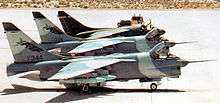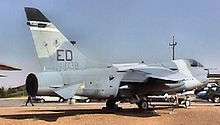Vought YA-7F
The Vought YA-7F "Strikefighter" is a prototype transonic attack aircraft based on the subsonic A-7 Corsair II. Two prototypes were converted from A-7Ds. The YA-7F was not ordered into production, its intended role being filled by the F-16 Fighting Falcon.
| YA-7F "Strikefighter" | |
|---|---|
 | |
| YA-7F prototype in 1989 | |
| Role | Attack aircraft |
| National origin | United States |
| Manufacturer | Ling-Temco-Vought/Vought |
| First flight | November 1989 |
| Status | Canceled |
| Primary user | United States Air Force |
| Number built | 2 |
| Developed from | LTV A-7 Corsair II |
Design and development
In 1985, the USAF requested proposals for a fast strike aircraft because of concerns that A-10 Thunderbolt II was too slow for interdiction. The design called for a new engine, either the Pratt & Whitney F100-PW-220 or General Electric F110-GE-100. LTV responded with the YA-7F, a supersonic version of A-7 powered by an F100-PW-220 with 26,000 lbf (116 kN) thrust. During the development process, Aviation Week & Space Technology magazine reported that, early on, LTV also experimented with adapting the afterburner from an F100-PW-220 to the existing Allison TF41 engine. Because the TF41 had a higher bypass ratio, the addition of the afterburner produced a much higher thrust (26,000lbf) than the F100 could produce (which was 23,770lbf), while retaining the greater fuel economy of the TF41. To accommodate the longer engine, the fuselage was lengthened about 4 ft (1.22 m). New fuselage sections were inserted in both the forward and aft fuselage – a 30 in (76 cm) section in front of the wing and an 18 in (46 cm) section behind the wing. The reasons were three-fold: (1) to accommodate engine length issues, (2) to accommodate aerodynamic issues with shape, and (3) to accommodate weight distribution issues. The increase in internal volume allowed for more fuel and other stores improvements. The wing was strengthened and fitted with new augmented flaps, leading edge extensions and automatic maneuvering flaps.

The vertical stabilizer height was increased about 10 in (25 cm), the unit horizontal tail was flipped from dihedral to anhedral, and control surfaces were flattened. The end result resembled the supersonic F-8 Crusader from which the original subsonic A-7 was derived. Many of the vehicle systems and mission systems were heavily modified and upgraded with leading edge technology, including a Molecular Sieve Oxygen Generating System and better cockpit displays. Low Altitude Night Attack Systems, an improved HUD and many software enhancements for navigation and weapons delivery were planned and being designed concurrently by Vought Dallas.
The new supersonic A-7 could accelerate with a 17,380 lb (7,880 kg) bomb load from 400 to 550 knots (1,020 km/h) in under 15 seconds and could sustain Mach 1.2 for longer times with the extra fuel. The YA-7F modifications allowed 7-g turn and burn capability that permitted high-speed sustained evasive maneuvers plus great improvements in high angle of attack performance. As a CAS/BAI platform to penetrate into enemy territory and return safely, the "Strikefighter" moniker was most fitting. Two A-7Ds were extensively modified, the first one flying on 29 November 1989, and breaking the sound barrier on its second flight. The second prototype flew on 3 April 1990.
The project was canceled due to improved relations with former adversaries, lower defense budgets, and the Air National Guard, by then the principal US operator of the A-7, generally favoring the in-production F-16 Fighting Falcon.
Variants


- YA-7F (A-7D Plus / A-7 Strikefighter)
- Stretched, supersonic version of A-7 powered by a Pratt & Whitney F100-220 turbofan, optimized for interdiction role, but cancelled after only two were built.
Aircraft on display
- 70-1039 – Hill Aerospace Museum, Hill AFB, Utah.[1]
- 71-0344 – Air Force Flight Test Center Museum, Edwards AFB, California.[2]
Specifications (YA-7F)
Data from Hill Aerospace Museum fact sheet[3]
General characteristics
- Crew: One pilot
- Length: 50 ft 1⁄2 in (15.253 m)
- Wingspan: 38 ft 9 in (11.81 m)
- Height: 16 ft 11 in (5.16 m)
- Empty weight: 23,068 lb (10,463 kg)
- Max takeoff weight: 46,000 lb (20,865 kg)
- Powerplant: 1 × Pratt & Whitney F100-PW-220 turbofan, 26,000 lbf (120 kN) with afterburner
Performanceat 40,000 ft
- Maximum speed: Mach 1.2
- Range: 2,302 mi (3,705 km, 2,000 nmi) maximum with four 300 gallon external tanks
- Service ceiling: 55,000 ft (17,000 m)
Armament
- Guns: 1× 20 mm (0.787 in) M61 Vulcan rotary cannon
- Hardpoints: external with a capacity of over 17,000 lb of ordnance,
See also
Related development
Related lists
References
Notes
- "YA-7F Strikefighter/70-1039." Archived 2016-03-03 at the Wayback Machine Hill Aerospace Museum. Retrieved: 22 March 2013.
- "YA-7F Strikefighter/70-1039." Archived 2017-01-02 at the Wayback Machine Air Force Flight Test Center Museum. Retrieved: 10 July 2015.
- YA-7F Hill Aerospace Museum faxt sheet Archived 2016-03-03 at the Wayback Machine
Bibliography
- NAVAIR 01-45AAA-1, A-7A/B Flight Manual. US Navy, 15 August 1973.
- NAVAIR 01-45AAE-1, A-7C/E Flight Manual. US Navy, 1 March 1973.
- Donald, David and Jon Lake, eds. Encyclopedia of World Military Aircraft. London: AIRtime Publishing, 1996. ISBN 1-880588-24-2.
- Dorr, Robert F. "A Plus for the Corsair". Air International, August 1987, Vol 33 No. 2. Bromley, UK:Fine Scroll. ISSN 0306-5634. pp. 61–65, 84–87, 93.
- Higham, Robin and Carol Williams. Flying Combat Aircraft of USAAF-USAF (Volume 2). Andrews AFB, Maryland: Air Force Historical Foundation, 1978. ISBN 0-8138-0375-6.
- Hobson, Chris. Vietnam Air Losses, USAF/USN/USMC, Fixed-Wing Aircraft Losses in Southeast Asia, 1961–1973. North Branch, Minnesota: Specialty Press, 2001. ISBN 1-85780-115-6.
- Swanborough, Gordon and Peter M. Bowers. United States Military Aircraft Since 1909. Washington, DC: Smithsonian Books, 1989. ISBN 0-87474-880-1.
- Swanborough, Gordon and Peter M. Bowers. United States Navy Aircraft Since 1911. London: Putnam, Second edition, 1976. ISBN 0-370-10054-9.
- Swanborough, Gordon and Peter M. Bowers. United States Navy Aircraft Since 1911. Annapolis, Maryland: Naval Institute Press, 1990. ISBN 0-87021-792-5.
- Wings of Eagles
External links
| Wikimedia Commons has media related to YA-7F Corsair II. |